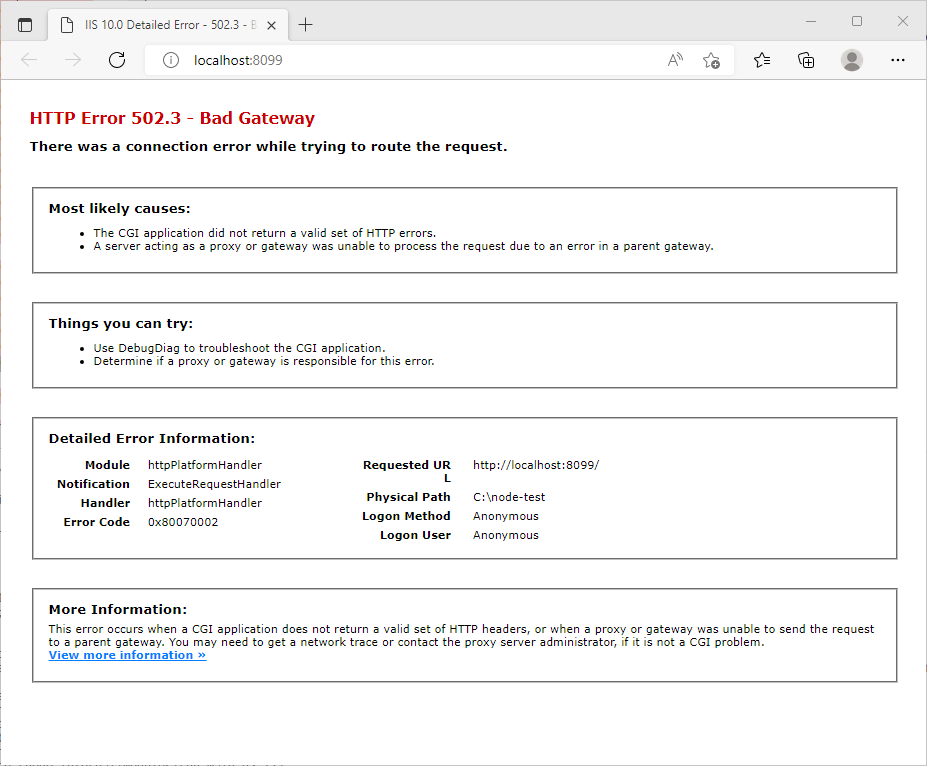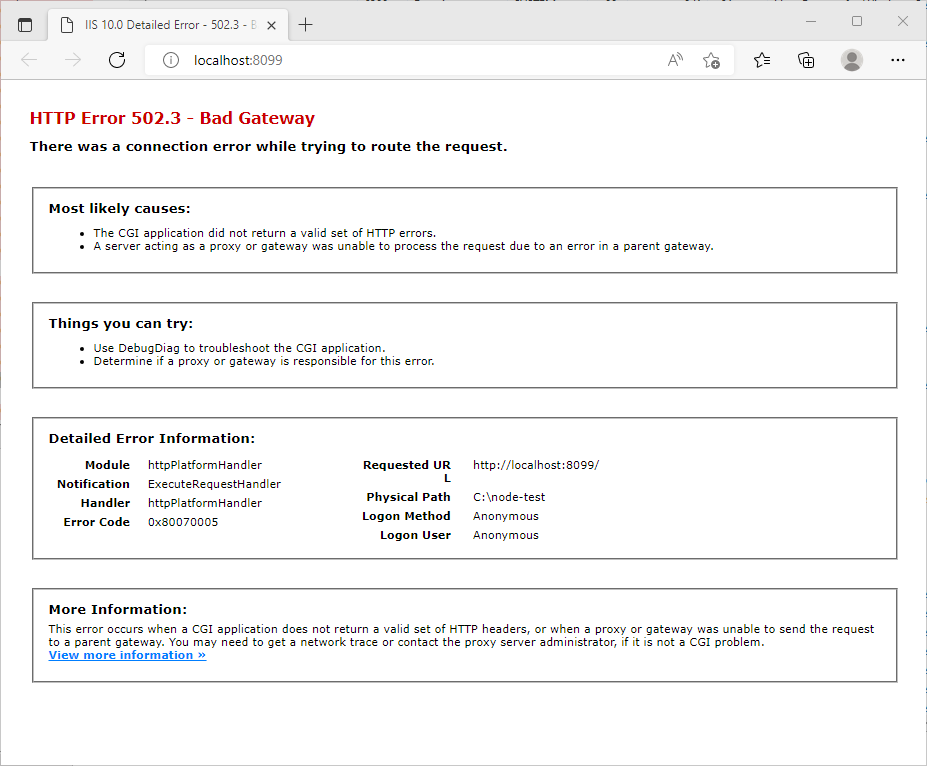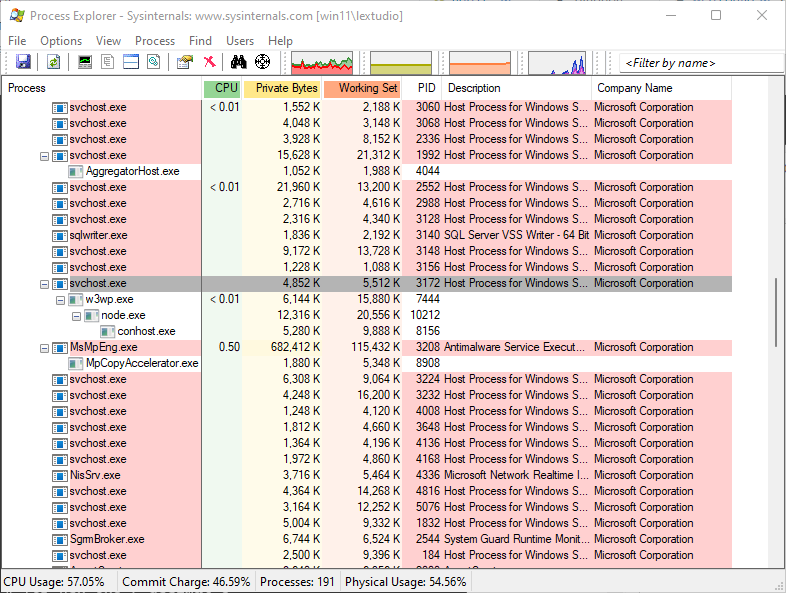Running Node.js Web Apps on IIS with HttpPlatformHandler
Step-by-step tutorial on deploying Node.js applications to IIS using HttpPlatformHandler with troubleshooting for common errors and next steps for Express, Socket.IO, and more
When Microsoft developed HttpPlatformHandler more than a decade ago to enable non-Microsoft web technologies on Windows/IIS, they didn’t know that one day
- Microsoft can embrace Linux in Azure
- Some Microsoft users stick to IIS with their Java/Python/Node.js/Go applications.
Thus, HttpPlatformHandler still plays an important role in the ecosystem and won’t go away easily. However, the landscape keeps evolving so this post tries to capture some latest changes on Node.js and show you how to proper set up everything needed and more critically how to troubleshoot if issues occur.
Prerequisites
To follow this post, you need to have the following software installed,
- Windows 10 or Windows Server 2016 or later (IIS 10 or later)
- HttpPlatformHandler v1.2 (from Microsoft) or v2.0 (from LeXtudio)
Basic Node.js Setup
No doubt we will start from a sample application as below,
1
2
3
4
5
6
7
8
9
10
11
12
13
import { createServer } from "http";
const port = process.env.PORT || 3000;
const requestListener = function (req, res) {
res.writeHead(200);
res.end("My first server");
};
const server = createServer(requestListener);
server.listen(port, function () {
console.log("Example app listening on port " + port + "!");
});
If we save it as C:\node-test\app.js, then on a Windows machine with Node.js installed, a simple command node app.js can launch the application at port 3000,
1
2
PS C:\node-test> node app.js
Example app listening on port 3000!
HttpPlatformHandler Setup
Now let’s download and install HttpPlatformHandler on IIS, and add a web.config in C:\node-test,
1
2
3
4
5
6
7
8
9
10
11
12
13
14
<?xml version="1.0" encoding="UTF-8"?>
<configuration>
<system.webServer>
<handlers>
<add name="httpPlatformHandler" path="*" verb="*" modules="httpPlatformHandler" resourceType="Unspecified" requireAccess="Script" />
</handlers>
<httpPlatform stdoutLogEnabled="true" stdoutLogFile=".\node.log" startupTimeLimit="20" processPath="C:\Program Files\nodejs\node.exe" arguments=".\app.js">
<environmentVariables>
<environmentVariable name="PORT" value="%HTTP_PLATFORM_PORT%" />
<environmentVariable name="NODE_ENV" value="Production" />
</environmentVariables>
</httpPlatform>
</system.webServer>
</configuration>
With all settings in place, I can go back to IIS Manager and create a site (I chose *:8099 as site binding) to point to C:\node-test. By opening a web browser and navigate to http://localhost:8099/, I can see “My first server” as expected.
Troubleshooting
0x80070002
But wait! Why did I see an error page saying “HTTP Error 502.3 - Bad Gateway” with Error Code 0x80070002?
 Figure 1: Bad Gateway error page of 0x80070002
Figure 1: Bad Gateway error page of 0x80070002
If you are very familiar with Windows error code, then you know that this error indicates “file not found”,
1
2
3
4
5
6
7
8
9
10
11
12
13
14
15
16
> .\Err.exe 80070002
# No results found for hex 0x4c5c572 / decimal 80070002
# for hex 0x80070002 / decimal -2147024894
COR_E_FILENOTFOUND corerror.h
DIERR_NOTFOUND dinput.h
DIERR_OBJECTNOTFOUND dinput.h
STIERR_OBJECTNOTFOUND stierr.h
DRM_E_WIN32_FILE_NOT_FOUND windowsplayready.h
E_FILE_NOT_FOUND wpc.h
# as an HRESULT: Severity: FAILURE (1), FACILITY_NTWIN32 (0x7), Code 0x2
# for hex 0x2 / decimal 2
STATUS_WAIT_2 ntstatus.h
# as an HRESULT: Severity: FAILURE (1), FACILITY_WIN32 (0x7), Code 0x2
ERROR_FILE_NOT_FOUND winerror.h
# The system cannot find the file specified.
# 8 matches found for "80070002"
So which part of our settings can trigger this error? Luckily our first attempt on C:\Program Files\nodejs\node.exe seems to raise a red flag,
 Figure 2: Node.js Windows shortcut
Figure 2: Node.js Windows shortcut
As the image shows, the Node.js installer creates a shortcut here, so that C:\Program Files\nodejs\node.exe is in fact C:\Users\<user name>\AppData\Roaming\nvm\v16.13.2\node.exe on this machine.
Note that the shortcut on your machine might point to a different location.
Due to the design of IIS, such shortcuts do not work very well, so we need to change web.config as below here,
1
2
3
4
5
6
7
8
9
10
11
12
13
14
<?xml version="1.0" encoding="UTF-8"?>
<configuration>
<system.webServer>
<handlers>
<add name="httpPlatformHandler" path="*" verb="*" modules="httpPlatformHandler" resourceType="Unspecified" requireAccess="Script" />
</handlers>
<httpPlatform stdoutLogEnabled="true" stdoutLogFile=".\node.log" startupTimeLimit="20" processPath="C:\Users\<user name>\AppData\Roaming\nvm\v16.13.2\node.exe" arguments=".\app.js">
<environmentVariables>
<environmentVariable name="PORT" value="%HTTP_PLATFORM_PORT%" />
<environmentVariable name="NODE_ENV" value="Production" />
</environmentVariables>
</httpPlatform>
</system.webServer>
</configuration>
Note that to learn all settings such as request timeout, you can refer to this article.
0x80070005
OK, now refreshing the browser gives us a different Bad Gateway error page because its Error Code changes to 0x80070005,
 Figure 3: Bad Gateway error page of 0x80070005
Figure 3: Bad Gateway error page of 0x80070005
1
2
3
4
5
6
7
8
9
10
11
12
13
14
15
16
17
18
> .\Err.exe 80070005
# No results found for hex 0x4c5c575 / decimal 80070005
# for hex 0x80070005 / decimal -2147024891
COR_E_UNAUTHORIZEDACCESS corerror.h
# Access is denied.
DIERR_OTHERAPPHASPRIO dinput.h
DIERR_READONLY dinput.h
DIERR_HANDLEEXISTS dinput.h
DSERR_ACCESSDENIED dsound.h
STIERR_READONLY stierr.h
STIERR_NOTINITIALIZED stierr.h
E_ACCESSDENIED winerror.h
# General access denied error
# as an HRESULT: Severity: FAILURE (1), FACILITY_WIN32 (0x7), Code 0x5
# for hex 0x5 / decimal 5
ERROR_ACCESS_DENIED winerror.h
# Access is denied.
# 9 matches found for "80070005"
This also makes perfect sense, because anything under C:\Users\<user name>\ is protected and accessible only by that user account by default, not IIS_IUSRS.
The End
Once I grant IIS_IUSRS read access to C:\Users\<user name>\AppData\Roaming\nvm\v16.13.2\node.exe, the browser starts to work as expected and gives me “My first server”.
With Process Explorer I can further analyze the node.exe process spin off by w3wp.exe,
 Figure 4: Node.js process under IIS
Figure 4: Node.js process under IIS
And if an application pool recycle is triggered in IIS Manager, I can also observe the two processes being shut down peacefully.
Note that the peaceful shutdown is via Windows API
OpenProcess(SYNCHRONIZE | PROCESS_TERMINATE, FALSE, m_dwProcessId). You can read ASP.NET Core module source code to learn more, as this module is derived from HttpPlatformHandler.
Side Notes
The Infinite Loading
Sometimes the browser seems to work as it is trying to load the web page but the page takes for ever to load and the node.exe process keeps crashing.
No doubt Process Monitor is the best tool to use right now and by using a filter of process name node.exe I can see lots of access denied errors on different files in C:\Users\<user name>.
That’s because the web app contents are in a user folder such as C:\Users\<user name>\source\repos\test-node-express, and node.exe has difficulty accessing them. The simplest way is to move the folder to a different location, such as C:\node-test.
Express for Node.js
One thing you might notice is that I wrote a very simple Node.js application as example. Why not go a little bit further to use a framework like Express for Node.js?
My latest test in 2024 with Node.js v21 and Express 4.18.2 works flawlessly, but when I tried out Node.js v16 and Express 4.18.1, node.exe did not shut down peacefully and it also blocked w3wp.exe from proper shutdown. You might need to dig further if such an issue occurs.
Socket.IO Support
If you want to use Socket.IO in your Node.js web apps, make sure IIS WebSocket Protocol support is installed and enabled. Then HttpPlatformHandler can work with Socket.IO without any issues.
Hosting on Azure App Service (Windows)
Two small changes might be needed if you want to deploy app.js and web.config together to your Azure App Service (Windows),
- You might need to change its name from
app.jstoapp.mjs, because Node.js 16+ might tell you thatSyntaxError: Cannot use import statement outside a module. So that the value ofargumentsnow should be.\app.mjs. - You might change the value of
processPathto simplynode.exeas Azure App Service seems to be able to resolve it to the correct executable.
The complete web.config file might look as below,
1
2
3
4
5
6
7
8
9
10
11
12
13
14
<?xml version="1.0" encoding="UTF-8"?>
<configuration>
<system.webServer>
<handlers>
<add name="httpPlatformHandler" path="*" verb="*" modules="httpPlatformHandler" resourceType="Unspecified" requireAccess="Script" />
</handlers>
<httpPlatform stdoutLogEnabled="false" stdoutLogFile=".\node.log" startupTimeLimit="20" processPath="node.exe" arguments=".\app.mjs">
<environmentVariables>
<environmentVariable name="PORT" value="%HTTP_PLATFORM_PORT%" />
<environmentVariable name="NODE_ENV" value="Production" />
</environmentVariables>
</httpPlatform>
</system.webServer>
</configuration>
Next.js
If you are working on a Next.js project, you might want to read my post on Next.js to learn more about how to deploy it to IIS.
Nuxt.js
Note that the steps below apply to Nuxt 2.x (2.15.8). To deploy a Nuxt 3.x web app, please refer to this new post.
If you are working on a Nuxt.js project, make sure you modify it further before deploying to IIS. The official guide for Azure Portal shows the general hints,
- Create
server\index.js. - Modify
nuxt.config.js.
but it misses important steps,
- You must add
expressandnuxt-startas dependencies (check yourpackage.json). - Change
const nuxt = await loadNuxt(isDev ? 'dev' : 'start')to simplyconst nuxt = await loadNuxt('start'), asisDevisn’t defined anywhere.
Then your web.config can work with HttpPlatformHandler as below,
1
2
3
4
5
6
7
8
9
10
11
12
13
14
<?xml version="1.0" encoding="UTF-8"?>
<configuration>
<system.webServer>
<handlers>
<add name="httpPlatformHandler" path="*" verb="*" modules="httpPlatformHandler" resourceType="Unspecified" requireAccess="Script" />
</handlers>
<httpPlatform stdoutLogEnabled="true" stdoutLogFile=".\node.log" startupTimeLimit="20" processPath="C:\Users\<user name>\AppData\Roaming\nvm\v16.13.2\node.exe" arguments=".\server\index.js">
<environmentVariables>
<environmentVariable name="PORT" value="%HTTP_PLATFORM_PORT%" />
<environmentVariable name="NODE_ENV" value="Production" />
</environmentVariables>
</httpPlatform>
</system.webServer>
</configuration>
I didn’t add the rewrite rules as the minimal sample project does not require them, but you can add them for your project if needed.
Node.js on IIS Express
You can take a look at the new open source HttpPlatformHandler v2.0 from LeXtudio.
Related HttpPlatformHandler Articles
This article is part of a series on using HttpPlatformHandler with IIS. To explore all related articles, please visit the httpplatformhandler tag page for the complete collection of guides and tutorials.